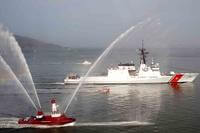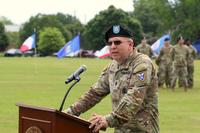A battle named “Checkpoint Pasta” might seem funny, considering it was fought by Italian troops, but there's nothing funny about being outnumbered and surrounded in Somalia. The story of the Italians who fought their way out of warlord Mohamed Farrah Aidid's complex ambush in July 1993 is one of incredible bravery and perseverance.
"Black Hawk Down," both the book and its 2001 film adaptation, forever enshrined Mogadishu in U.S. military history. The losses of four Black Hawks and the U.S. Army's efforts to recover the remains of the fallen (and one prisoner of war) during Operation Gothic Serpent led to the most intense close combat U.S. troops had seen since the Vietnam War. For the Italian Army, it had been much, much longer.
Italy contributed more than 4,000 troops to the United Nations intervention in Somalia, UNISOM II. Ater the United States, the Italians were the second-largest contingent in the country and maintained relatively good relations with the locals.
But by the time of the "Black Hawk Down" incident, that relationship broke down. The Italians could have warned the Americans how quickly a routine mission could go wrong there. Just three months before the U.S. launched Gothic Serpent against Mohamed Farrah Aidid, Italian soldiers were fighting for their lives against his massive militia.

In 1993, Somalia was in the second year of its ongoing civil war. Like the other countries involved in UNISOM II, Italy deployed its troops to support the U.N. in distributing aid and relief while trying to foster reconciliation between the warring factions and saw some shining successes.
On July 2, 1993, 500 Italian troops and two columns of armored vehicles met at Haliwa, a neighborhood just north of the capital, on a mission to search and confiscate weapons. Named Operation Kangaroo 11, it was a mission they'd conducted many times since deploying to Somalia.
This time, however, the search was aided by a hundred Somali policemen. What the Italians didn't know was that the police were loyal to a rival, Ali Mahdi Muhammad. When the locals saw Muhammad's men, they immediately believed they were about to be attacked.
The search area was 2,800 square meters, bisected by a crossroads, between two checkpoints, Ferro and Pasta (so named because of an old Barilla pasta factory nearby). It began around 6 in the morning and started off like normal. Weapons were found, arrests were made and the Italian commanders met with local leaders to explain what was happening.
Around 7:40 a.m., fires began burning in the area, and a crowd of Somalis began protesting and throwing stones. Italian Gen. Bruno Loi, seeing tires throw up heavy smoke, decided it was time to end the operation.
While the Italians spent three hours that morning conducting their search, Aidid's militia was mobilizing. The two Italian armored columns left the area, and as Alfa column headed toward the Old Port, Bravo column moved toward the Italian base at Balad -- but Alfa's withdrawal was blocked near Checkpoint Pasta.
Cut off by barricades of overturned cars, burning tires and old furniture, Italian paratroopers in VCC-1s armored personnel carriers were swarmed by women and children. It wasn't long before the shooting started. Behind the women and children, Aidid's militia began firing on the Italians with AK-47s and RPG-7s. The Italian Army began its first armed combat in 50 years.
Two detachments of paratroopers went on the offensive, raiding Somali dugouts, houses and sniper positions with hand grenades. With the besieged column surrounded by women and children throwing stones, Aidid's militia began shooting from behind the crowd as small arms fire rained down on the Italians from the windows in the buildings above.
Bravo column, with M60 tanks, Fiat 6614 armored cars and B1 Centauro tank destroyers, had almost reached the Italian base at Balad when it learned about what was happening at Checkpoint Pasta. Volunteers from the column immediately reversed course and began the 20-kilometer race back to Mogadishu.
Colour Sergeant Major Stefano Paolicchi was hit by sniper fire as they moved, becoming Italy's first combat casualty since World War II. Back at Pasta, one of the VCC-1s was hit by a rocket-propelled grenade, disabling it and killing paratrooper Pasquale Baccaro while forcing the Italians out of their relative safety.
The paratroopers took positions to defend the wounded as the VCC-1s returned fire using their .50-caliber onboard guns and MG-42s. Aidid's militia started raining mortar fire down on the Italians from their positions inside the pasta factory. The two sides were just 65 feet away from each other, firing a "blizzard" of bullets that filled the square near Pasta.
By this time, the entire neighborhood was in upheaval. New barricades were going up, and more Somalis were rushing toward the intersection. The paratroopers knew they were trapped and that Aidid's men were trying to surround them, so they started kicking in doors and clearing houses and roofs one by one. In the square below, the vehicles arranged themselves to form an effective crossfire.
The VCC-1 hit by the RPG was restarted amid the fighting and the wounded were reloaded and moved from harm's way, but no real help could come. The fighting was too intense for a medevac, and ambulances' routes were blocked by the barricades. It was also too intense for the Italians' A-129 Mangusta helicopters to provide air support.
When the Somalis captured two of their VM-90 combat vehicles, the helicopters were finally allowed to fire, but only destroy the stolen vehicles and prevent the militia from turning their .50-caliber machine guns on the Italians.
By 11 a.m., the Italians turned their attention to the pasta factory and began to pour .50-caliber ammunition into it. Accurate fire and grenades from the Italians, even though they were mostly in the open in the middle of a crossroads, began to take its toll on the militia.
The Italians had larger-caliber weapons, such as those of the M60 tanks and the Fiat 6614s, but were not allowed to use them due to the international rules of engagement, which required a proportional response and deference to civilian safety.
It was M60 tank rounds from Bravo column that finally allowed the Italians to disengage at 1 p.m., narrowly avoiding an all-out battle with the entire city.

After the last Italian armored vehicle left the area, American Cobra gunships signaled the area as a "five-minute kill zone," which meant everything still remaining in the area of Checkpoint Pasta would be declared an enemy and shot by the Cobras. The Cobras gave the Italians plenty of space to head back to their bases.
Sometime later, the Italians learned Aidid changed his hiding place every night, and they had almost stumbled upon him in that neighborhood. The Battle of Checkpoint Pasta was only supposed to be a diversion to allow him to escape. The two sides fought for about four hours before the Italians returned to their bases. Amazingly, only three Italians were killed and 23 were wounded, while Aidid's men suffered an estimated 100 killed and 400 wounded.
Want to Learn More About Military Life?
Whether you're thinking of joining the military, looking for post-military careers or keeping up with military life and benefits, Military.com has you covered. Subscribe to Military.com to have military news, updates and resources delivered directly to your inbox.
















